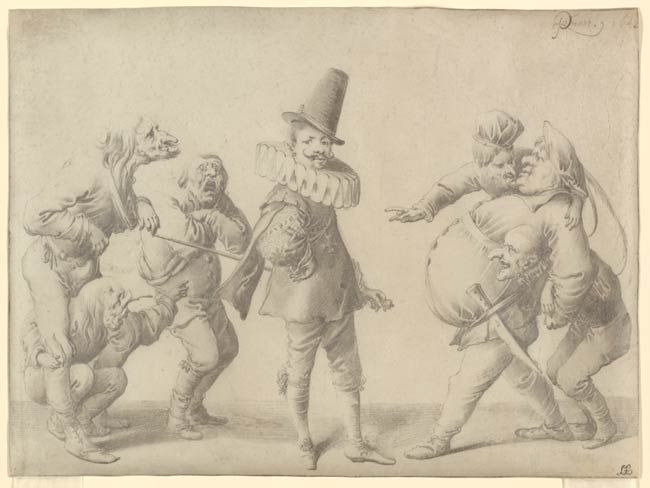
Pieter Quast offered a humorous, caricatural view of contemporary Dutch life. His works are populated with stock figures such as beggars, drinkers, quack doctors, dwarves, and the like, all readily recognizable to Quast's audience. Some of Quast's works not only derive from theatrical types, however, but are even based on actual theatrical productions. These include the present work, one of a group by Quast that seemingly reflect performances of "The Spanish Brabanter" by Gerbrand Adriaensz Bredero. Originally performed in 1617, the play remained popular through the seventeenth century. The drama consists of a series of picaresque episodes involving the fantasist Jerolimo, the eponymous “Brabanter,” from the Brabant province in the Southern Netherlands. He has fled his debts in Antwerp and arrived in Amsterdam, where he pretends to be a rich man, adopting the elaborate costume of the Spanish, albeit a version that was long out of date, complete with the enormous millstone ruff. He repeatedly encounters commonfolk who see through his pompous disguise. Jerolimo's Spanish costume and braggadocio clearly derive from the stock commedia dell'arte character of the Capitano. The play remained popular, however, not only for its amusing mockery of human nature, but also because of the prevailing sentiment against the Spanish (and against immigrants from the Spanish Southern Netherlands) during the Eighty Years' War: Jerolimo could stand in for both.
Signed and dated at lower right, black ink "PQuast 1642" (PQ in monogram).
Lucas, Lionel, 1822-1982, former owner.
Lucas, Charles, former owner.
B.A. Stanton-Hirst, "Pieter Quast and the Theatre," Oud Holland, 96 (1982), p. 232, note 27
